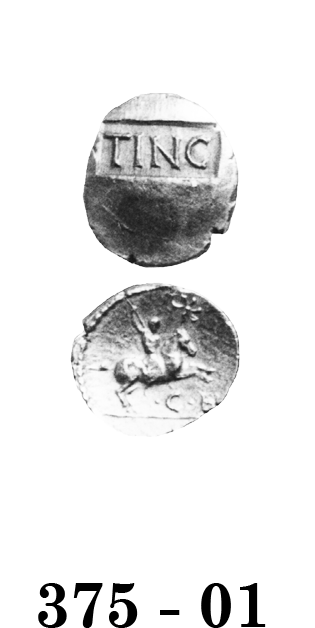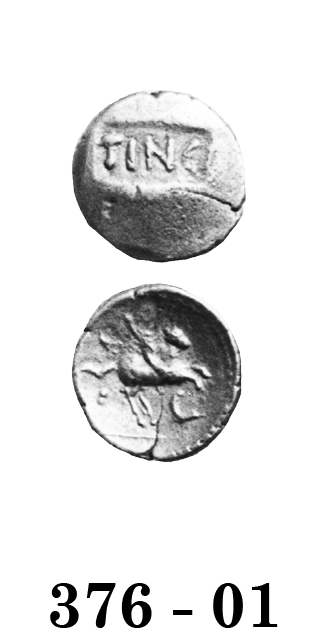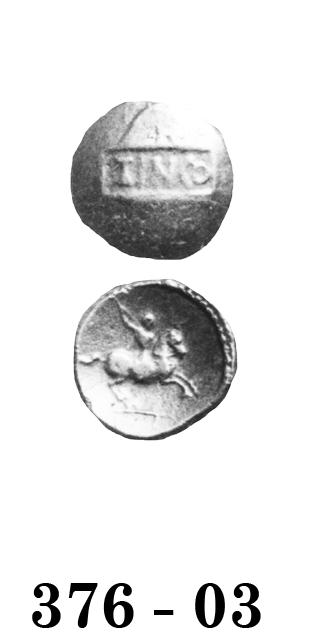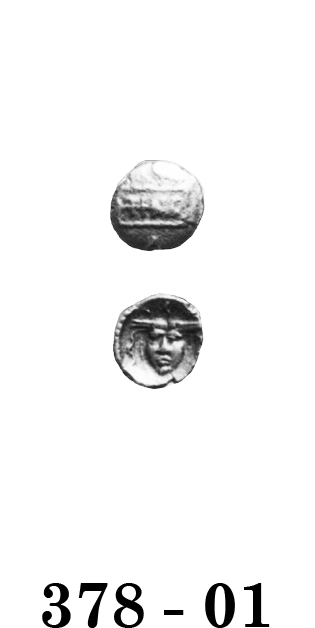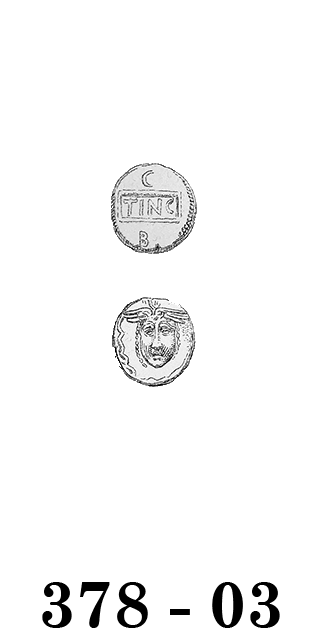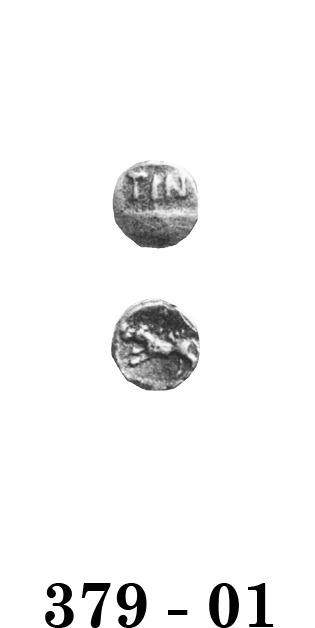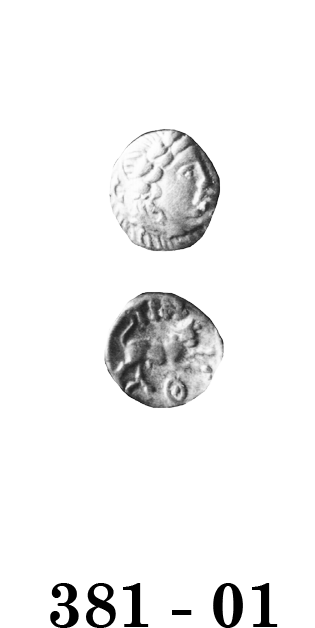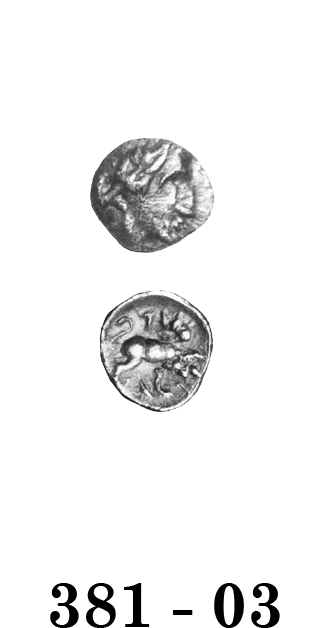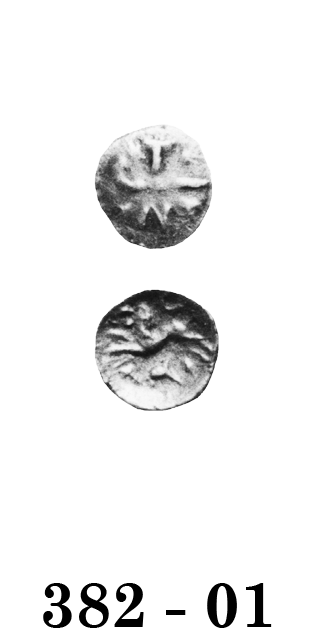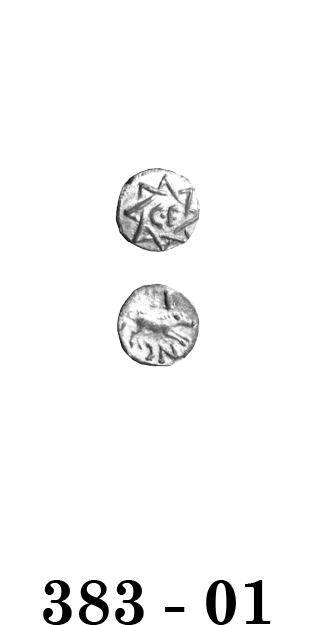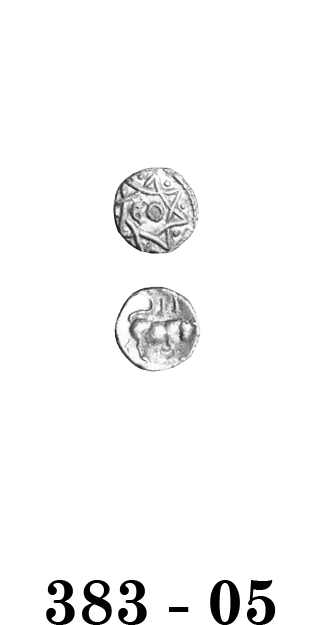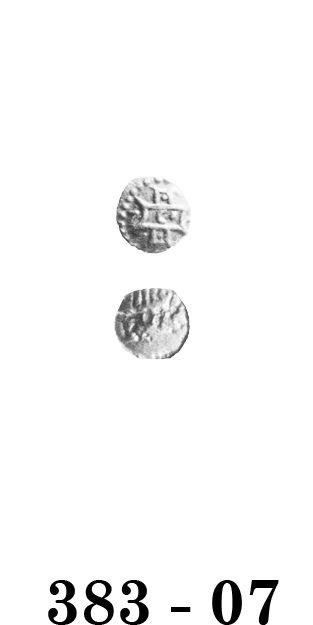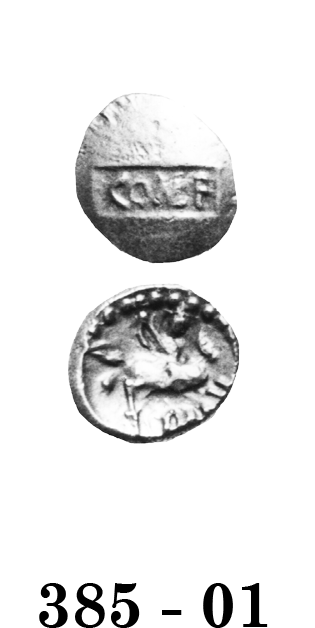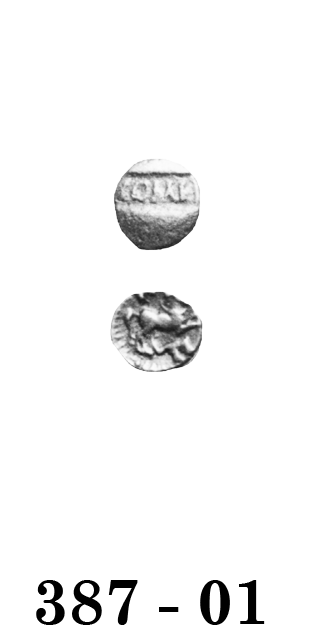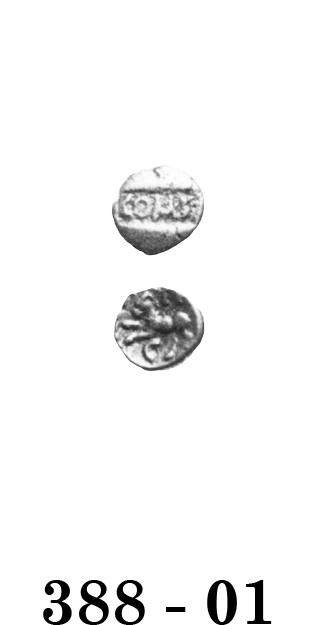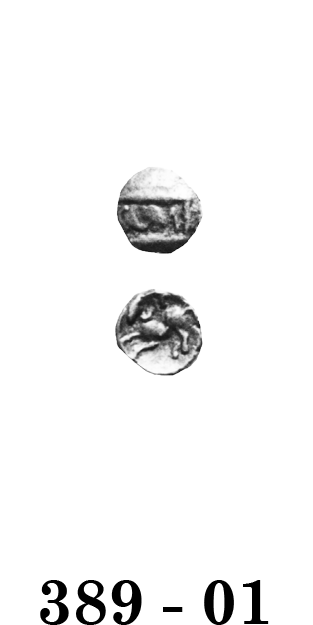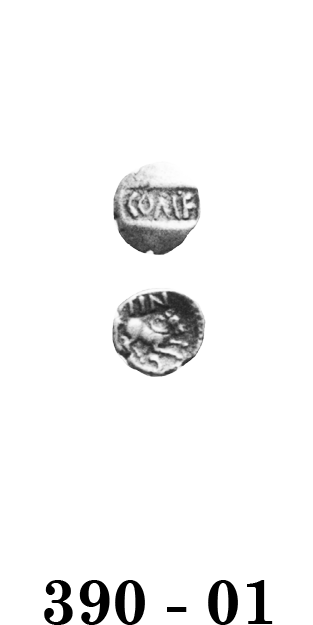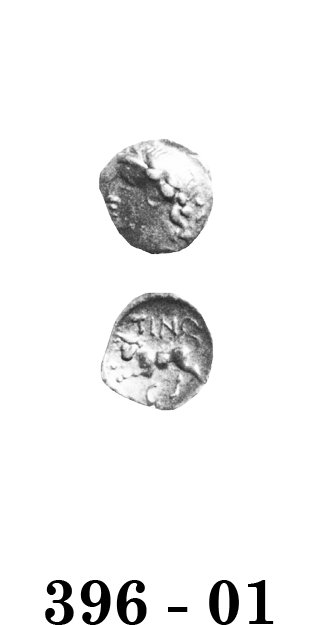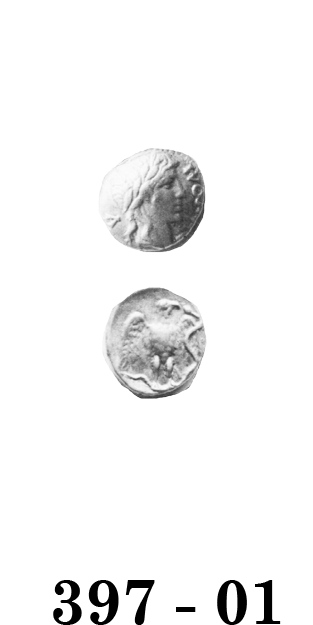
Celtic Coinage of Britain
third edition
Click on coin to see hidden information
Coinage of Tincomarus
The next name appearing on the coins is Tincomarus. His rule, lasting about 25 years, ended during the Trinovantian/Catuvellaunian Interregnum. Tincomarus afterwards appears in Rome seeking assistance from Augustus – evidently he had been deposed. The historical Tincomarus, mentioned on the Monumentum Ancyranum (constructed about 7 A.D.) has traditionally been associated with the Atrebatic coins.
Tincomarus' coinage is divided into three periods based on the stater types. The corresponding quarter staters and silver coins are assigned according to their inscriptions and on typological grounds. The more Romanized designs on the silver are assigned to the later periods.
Originally, this ruler was known as Tincommius, however, a more complete inscription on an Alton Hoard coin has provided a better reading of the name.
Tincomarus Second Coinage
Mack indicated the mounted warrior theme on the following staters is probably adapted from Roman denarii of the Crepusia family. The C.F. inscription is an abbreviation for Commius Filius.
Simon Bean suggests the tablet motif is adapted from counterstamps on roman coins. This cannot be proven, and the dating of the Roman counterstamped coins is problematic. However, if the suggestion were true, the coins could be dated five years later than the dates given in this catalogue.
Tincomarus Third Coinage
On Tincomarus' third coinage, the ruler emphatically proclaims to be the son of Commius. Possibly, a weakening grip on the rule prompted this claim of legitimacy.
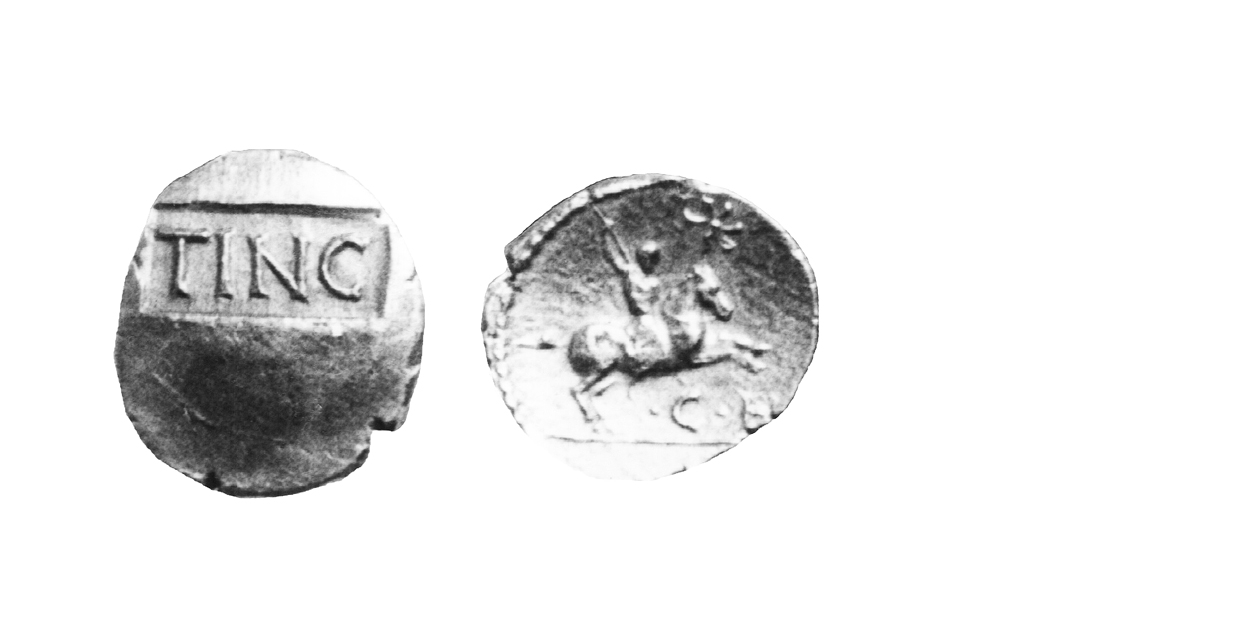
375 - 01 Tincomarus Second Coinage
25-20 B.C. Scarce
Gold Stater 5.3 gms. 16 mm
Earliest Record: Poste, 1846
OBV: Inscribed tablet
Identifying points:
- TINC in tablet
REV: Celtic warrior on horse right
Identifying points:
- warrior holds spear
- six pointed star above horse's head
- C F with pellets below horse
- exergual line below horse
CLASSIFICATION: Atrebatic E
NOTES:
- Typical weight given
- Some in museums
- Reverse adapted from a denarius of P. Crepusius
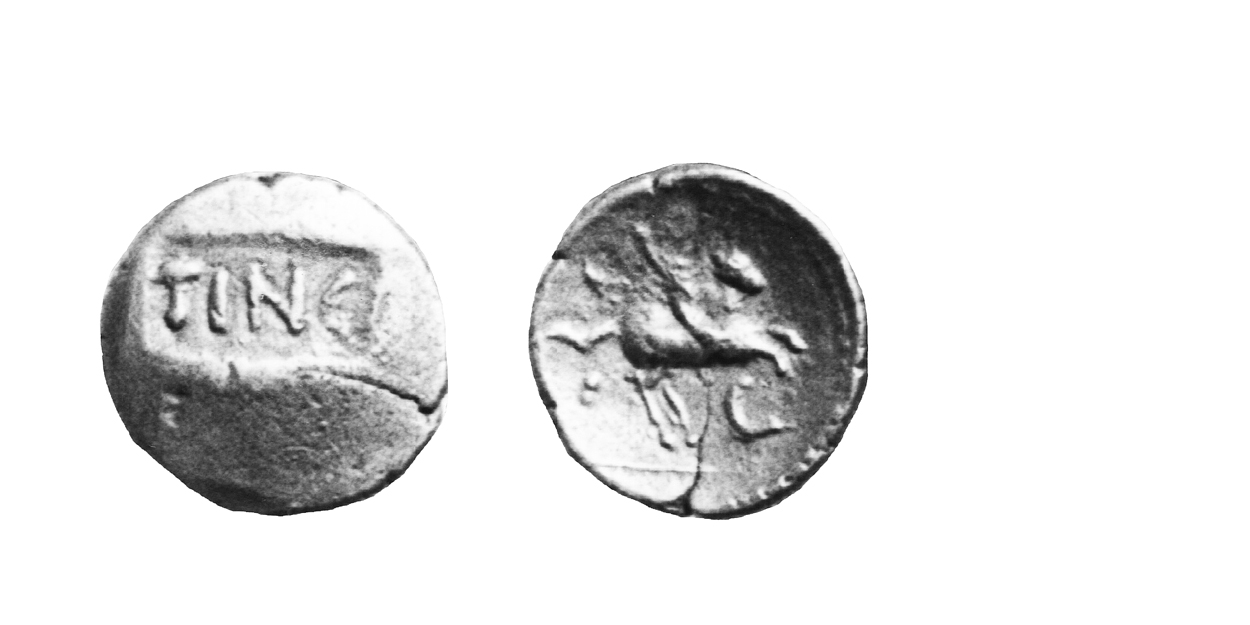
376 - 01 Tincomarus Second Coinage
25-20 B.C. Very Rare
Gold Stater 4.9 gms.
Earliest Record: Mack, 1953
OBV: Inscribed tablet
Identifying points:
- TINC in tablet
REV: Celtic warrior on horse right
Identifying points:
- as 375 - 01 but no star above horse's head
- large C in C F
CLASSIFICATION: Atrebatic E
NOTES:
- Weight of one example given, not believed to be typical
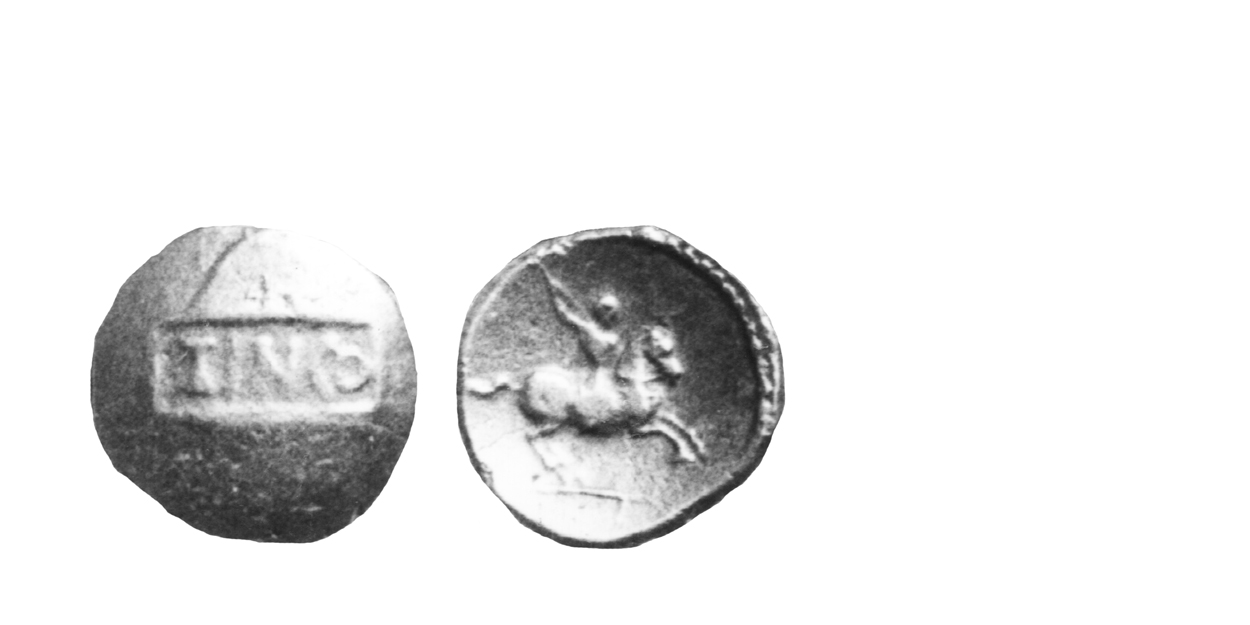
376 - 03 Tincomarus Second Coinage
25-20 B.C. Very Rare
Gold Stater 17 mm
Earliest Record: Evans, 1890
OBV: Inscribed tablet
Identifying points:
- as 376 - 01, but TINCO in tablet
REV: Celtic warrior on horse right
Identifying points:
- as 376 - 01, but no inscription
CLASSIFICATION: Atrebatic E
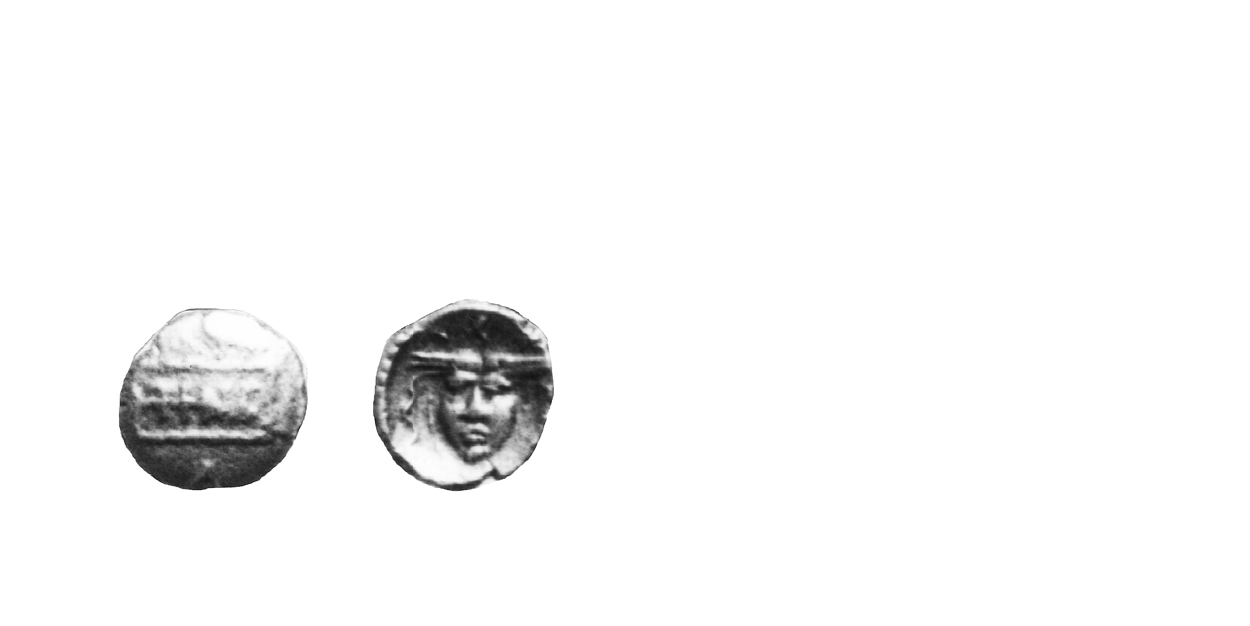
378 - 01 Tincomarus Medusa Type
25-20 B.C. Rare
Gold Quarter Stater 1.0 gm 10 mm
Earliest Record: Evans, 1864
OBV: Inscribed tablet
Identifying points:
- TINC on tablet
- C above tablet
- A below tablet
- pellet border
REV: Medusa head
Identifying points:
- head faces viewer
- pellet border
CLASSIFICATION: Atrebatic E
NOTES:
- Some in museums
- Typical weight given
- Many found at Wanborough
- Celtic Coin Index records indicate rarer that originally thought
- Evans 1864 reported a variety with "F" below the tablet
- Willett 1879, p. 14 suggested Evans had misread the "F"
- Evans 1890 reported varieties with "A" or "B" below the tablet
- "C" may indicate Calleva mint, the "A" or "B" some subdivision within the mint
- Reverse adapted from a denarius of L. Cornelius Lentulus
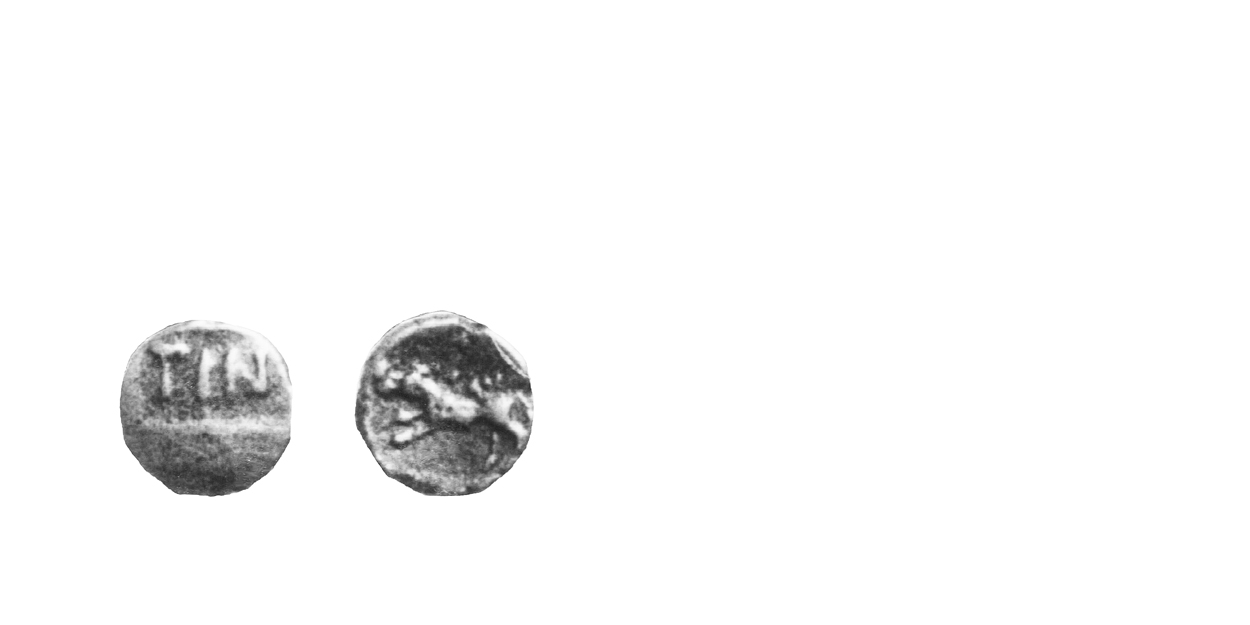
379 - 01 Tincomarus Second Coinage
25-20 B.C. Very Rare
Gold Quarter Stater 1.1 gms. 9 mm
Earliest Record: Evans. 1890
OBV: Inscribed tablet
Identifying points:
- TIN on tablet
REV: Celticized horse left
Identifying points:
- three pointed star above horse
CLASSIFICATION: Atrebatic E
NOTES:
- Celtic Coin Index records indicate rarer than thought
- Some found at Wanborough
- Typical weight given
- Some in museums
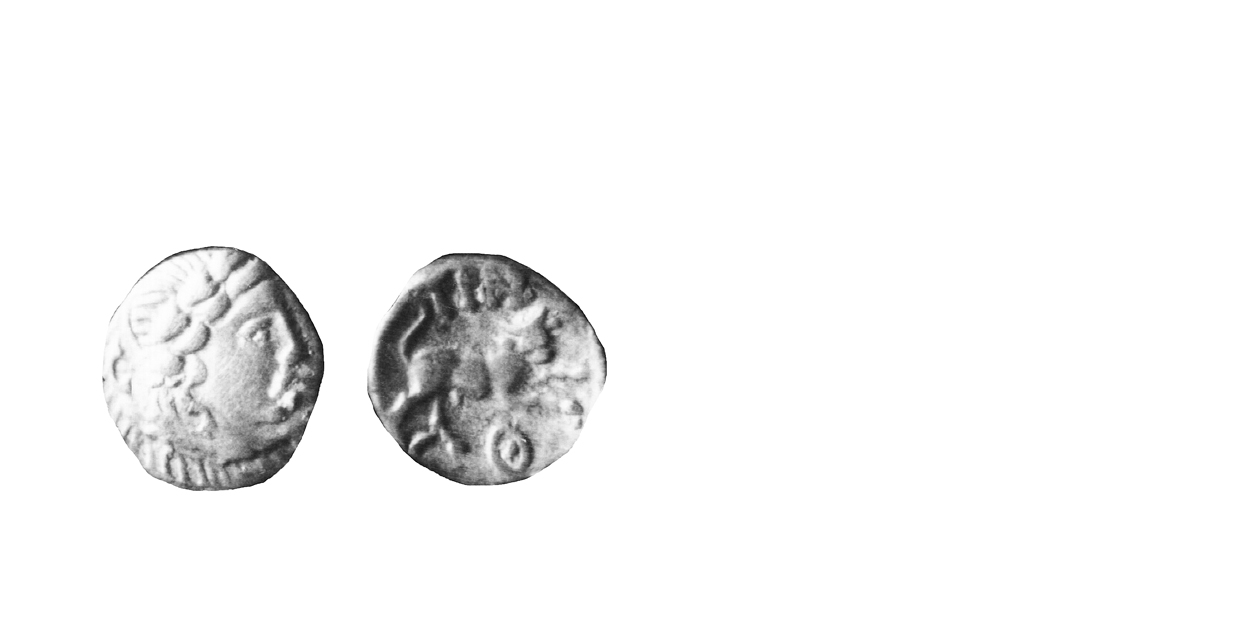
381 - 01 Tincomarus Second Coinage
25-20 B.C. Rare
Silver Unit 12 mm
Earliest Record: Van Arsdell, 1989
OBV: Celticized head right
Identifying points:
- head has laurel wreath
- short lines for hair
REV: Charging bull right
Identifying points:
- Bull rears on hind legs
- TIN above bull
- pellet-in-ring motif below bull
- bull's head faces
CLASSIFICATION: Atrebatic E
NOTE:
- Some in museums
- V381-01 is not Mack 101, as previously reported, but a different type
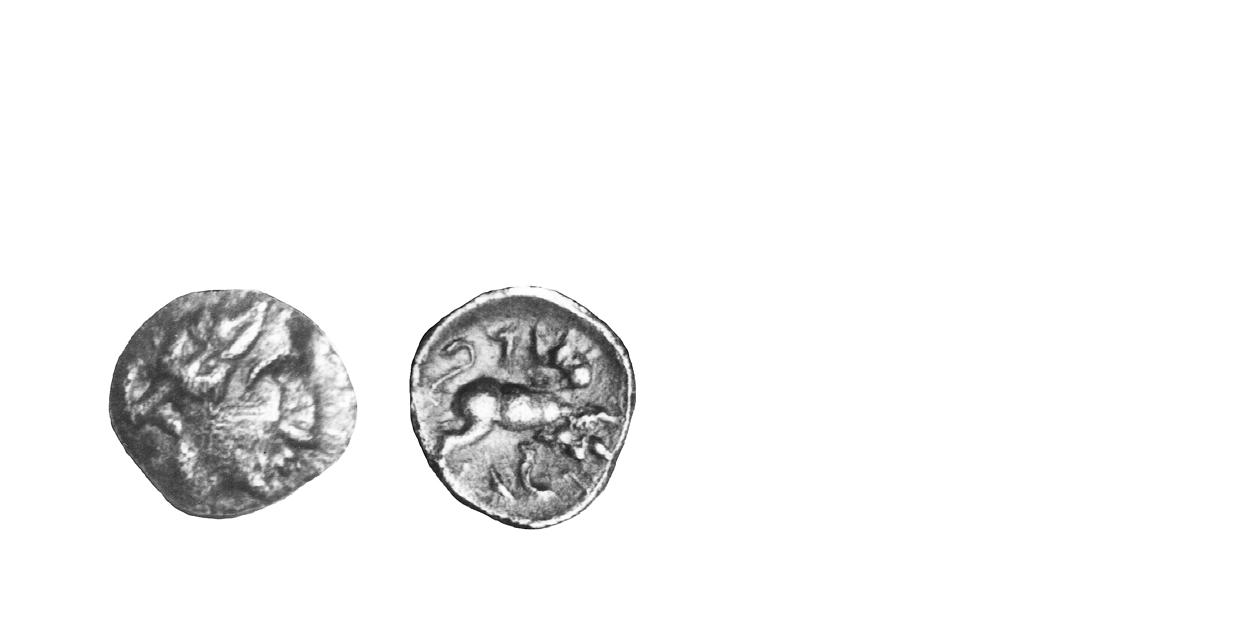
381 - 03 Tincomarus Second Coinage
25-20 B.C. Very Rare
AR Unit 12 mm
Earliest Record: Van Arsdell, 1989
OBV: Celticized head right
Identifying points:
- as 381 - 01, but cruder head
REV: Celticized bull? right
Identifying points:
- Bull butting
- TI above bull
- NC below bull
CLASSIFICATION: Atrebatic E
NOTES:
- Type possibly from Wanborough, now known to be commoner than previously thought
- Not authenticated via metallurgical analysis, but appears genuine
- Image of reverse animal is too badly preserved to be certain it is a bull
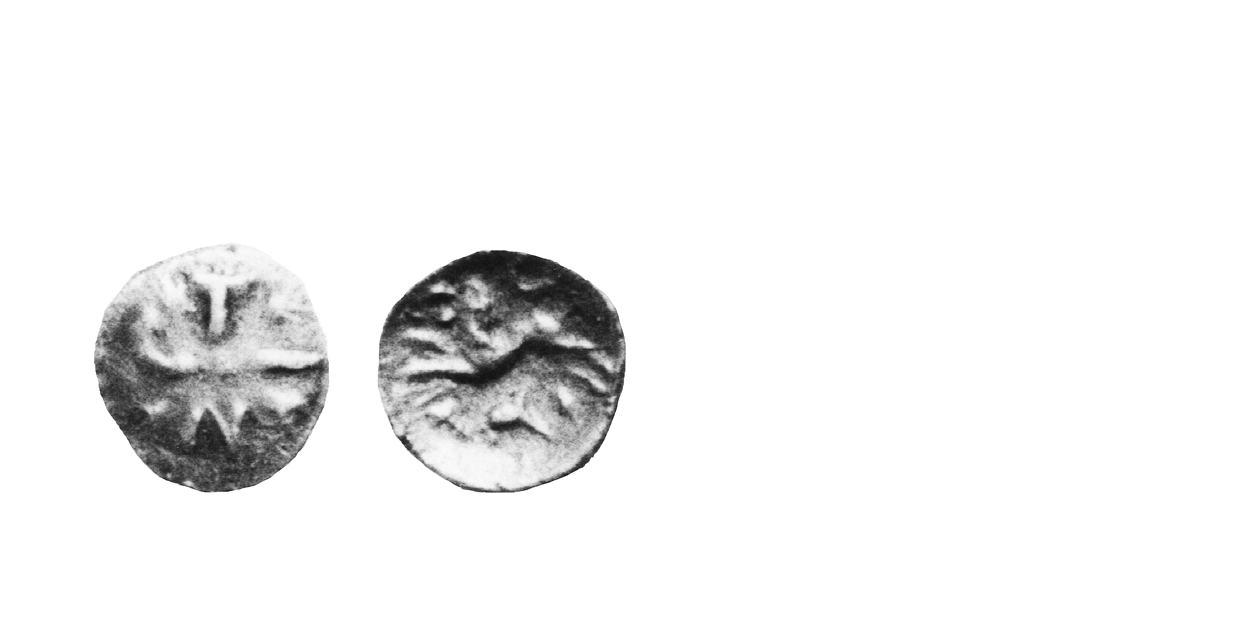
382 - 01 Tincomarus Second Coinage
25-20 B.C. Extremely Rare
Silver Unit 13 mm
Earliest Record: Mack, 1975 (Chichester, 1969 find)
OBV: Inscription
Identifying points:
- TINC around central pellet
REV: Animal left
Identifying points:
- animal prancing
CLASSIFICATION: Atrebatic E
NOTES:
- Some found at Wanborough
- Celtic Coin Index records indicate rarer that originally thought
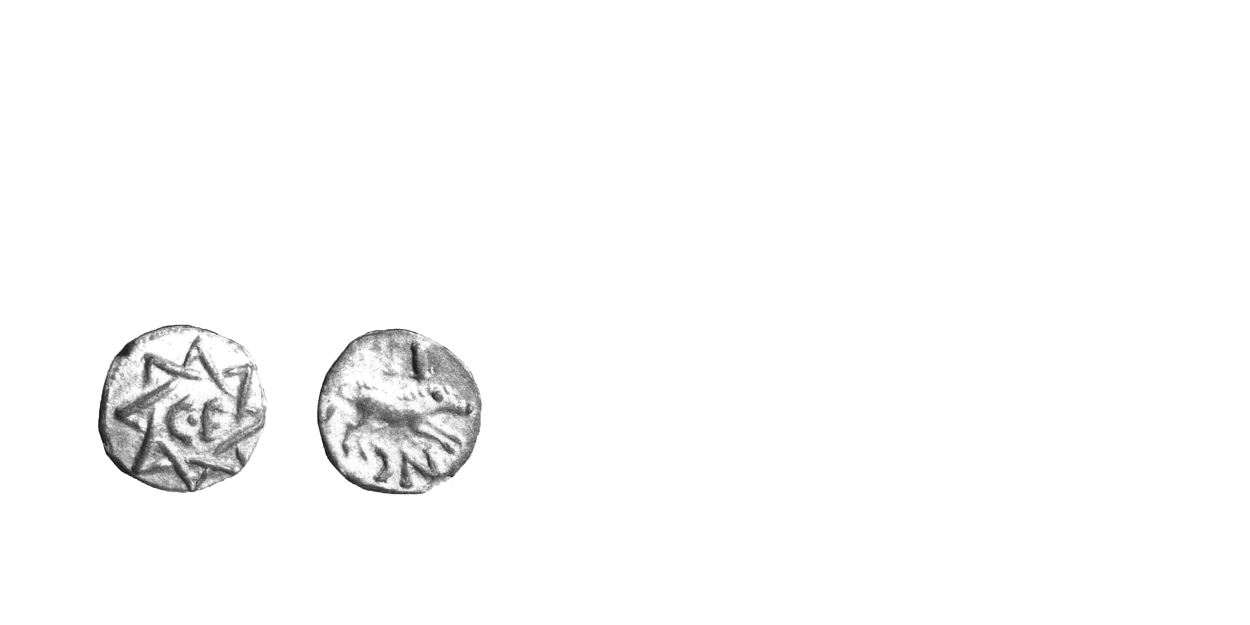
383 - 01 Tincomarus Second Coinage
25-20 B.C. Very Rare
Silver Minim 0.4 gms. 9 mm
Earliest Record: Evans, 1864
OBV: Geometric pattern
Identifying points:
- two interlocking squares
- squares have inwardly-curved sides
- 'C.F' in centre
REV: Animal right
Identifying points:
- animal probably a boar or dog
- T I above animal
- N C below animal
CLASSIFICATION: Atrebatic E
NOTES:
- Some found at Wanborough
- Celtic Coin Index records indicate rarer than originally thought
- Simon Bean suggests the reverse image is adapted from coins of Augustus
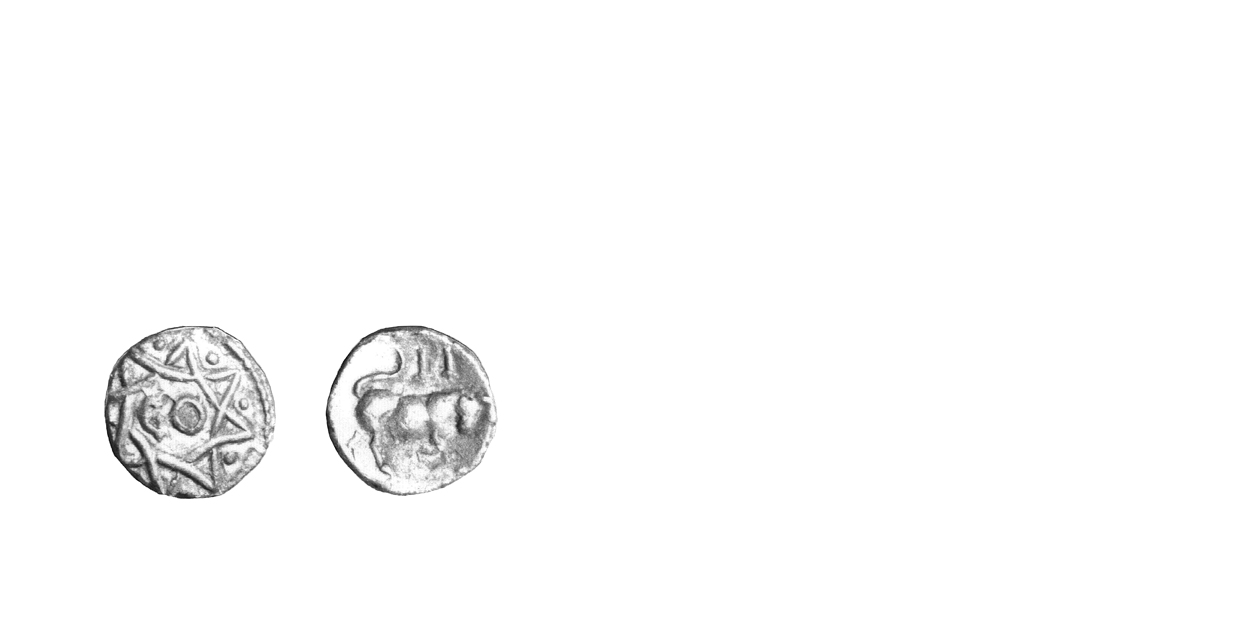
383 - 05 Tincomarus Second Coinage
25-20 B.C. Extremely Rare
Silver Minim 0.4 gms. 9 mm
Earliest Record: Van Arsdell, 1989
OBV: Geometric pattern
Identifying points:
- two interlocking squares
- C O inside squares
- pellet border
- pellets in angles
REV: Bull right
Identifying points:
- bull butting right
- TI above bull
CLASSIFlCATION: Atrebatic E
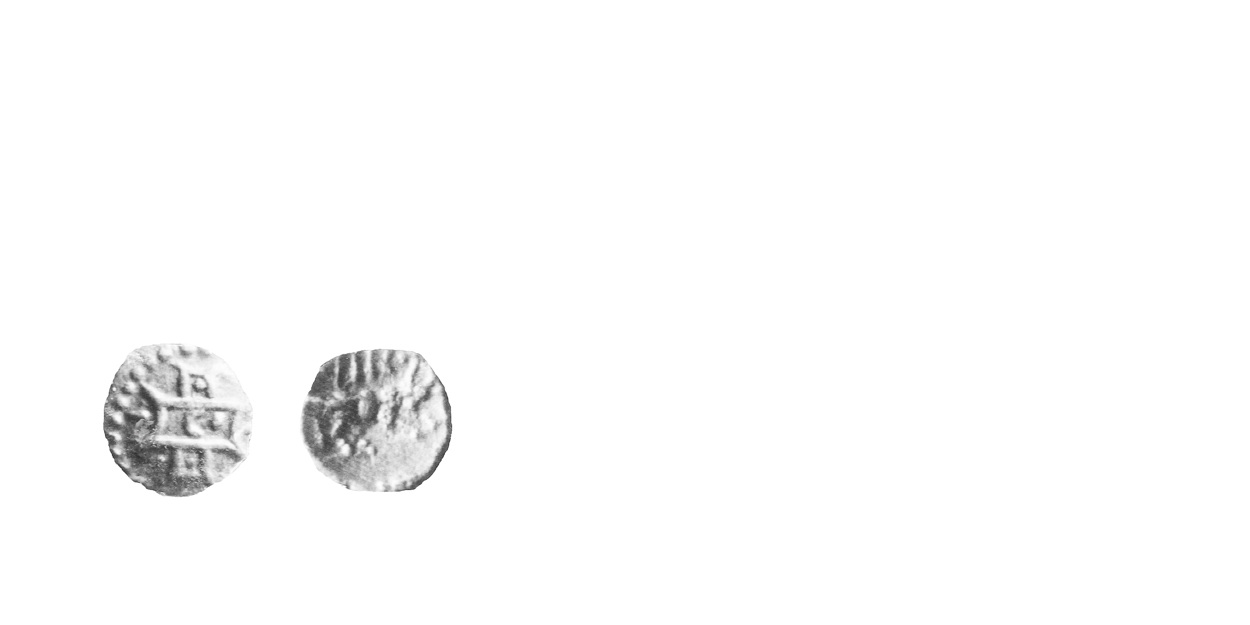
383 - 07 Tincomarus Second Coinage
25-20 B.C. Extremely Rare
Silver Minim 8 mm
Earliest Record: Van Arsdell,1989
OBV: Letter C in box
Identifying points:
- C with pellet to right, all inside box
- box has curved sides
- box-with-pellet above and below central box
- pellet on each side of central box
REV: Bull right
Identifying points:
- bull butting
- TIN above bull
CLASSIFICATION: Atrebatic E
NOTES:
- Image of reverse animal is too badly preserved to be certain it is a bull
388 - 01 now reattributed as 488 - 01
A better preserved example now shows the legend to be that of Verica.
Go to 488 - 01
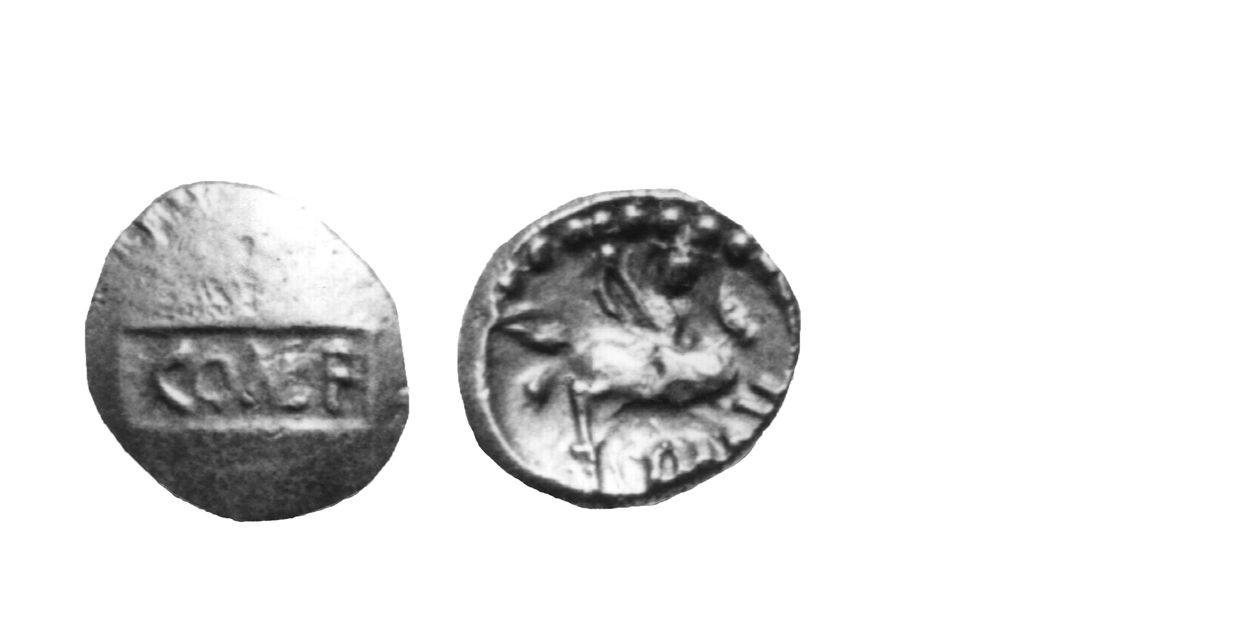
385 - 01 Tincomarus Third Coinage
20-10 B.C. Common
Gold Stater 5.40 gms. 18 mm
Earliest Record: Camden, 1610 (Philemon Holland edition)
OBV: Inscribed tablet
Identifying points:
- COM.F in tablet
REV: Celtic warrior on horse right
Identifying points:
- warrior holds spear
- star and three pellets behind horse and rider
- TIN below horse
- pellet border
CLASSIFICATION: Atrebatic F
NOTES:
- Standard weight estimated, the true standard is probably 0.1 to 0.2 grammes heavier
- Most are in museums
- Reverse adapted from a denarius of P. Crepusius
- Possible Gold/Bronze plated core of 385 - 01 recorded in Stukeley, 1776, plate 22, number 2
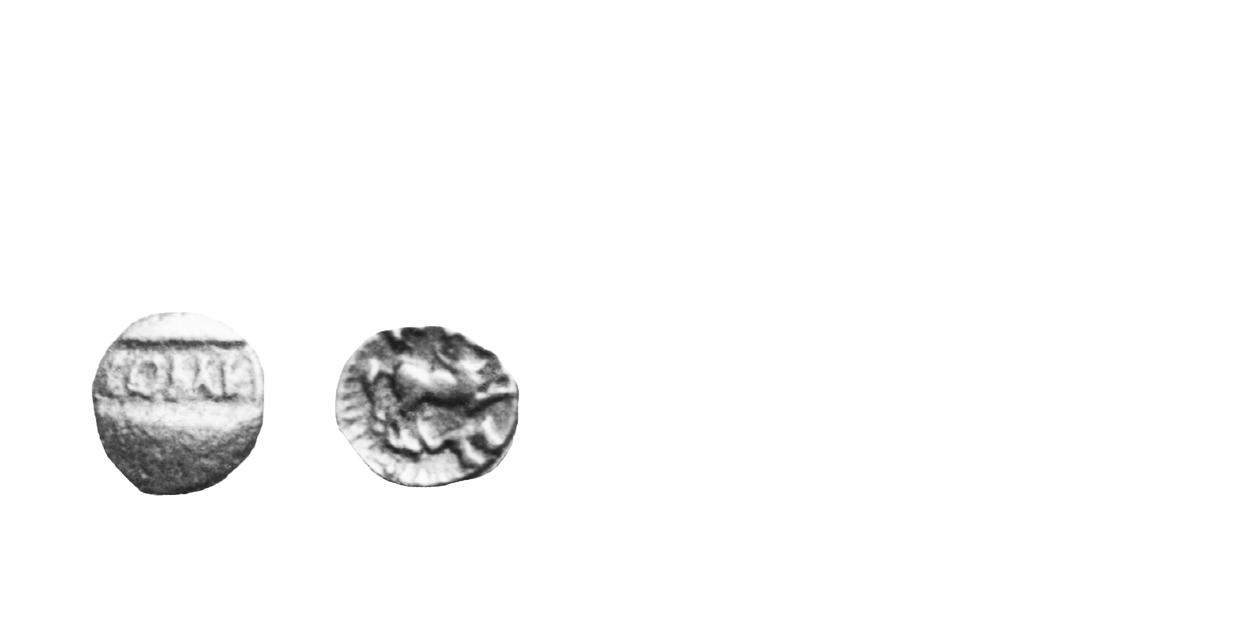
387 - 01 Tincomarus Third Coinage
20-10 B.C. Extremely Rare
Gold Quarter Stater 1.2 gms. 8 mm
Earliest Record: Evans, 1864
OBV: Inscribed tablet
Identifying points:
- COMF in tablet
REV: Celticized bull right
Identifying points:
- TI below bull
- N above bull
CLASSIFICATION: Atrebatic F
NOTES:
- Some in museums
- Typical weight given
- Some found at Wanborough
- Celtic Coin Index records indicate rarer than originally thought
- Reverse adapted from a denarius of L Thorius Balbus
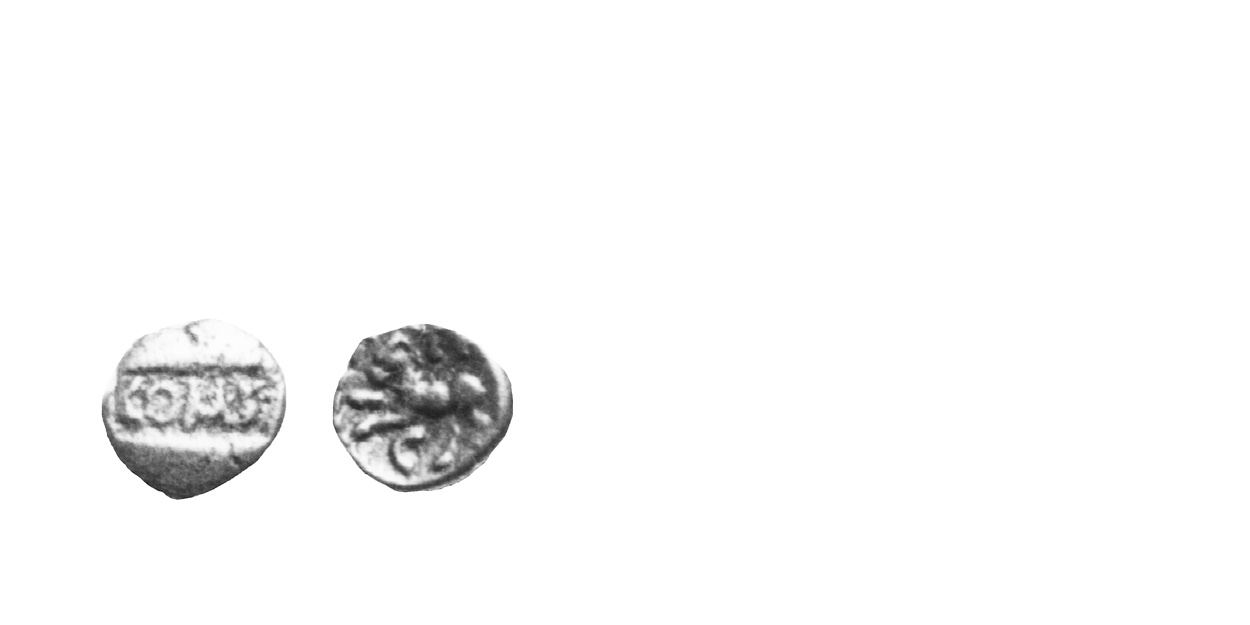
388 - 01 Tincomarus Third Coinage
20-10 B.C. Very Rare
Gold Quarter Stater 1.2 gms. 8 mm
Earliest Record: Evans, 1980
OBV: Inscribed tablet
Identifying points:
- COMF in tablet
REV: Celticized horse left
Identifying points:
- TI above horse
- C below horse
CLASSIFICATION: Atrebatic F
NOTES:
- Typical weight given
- Many found at Wanborough
- Celtic Coin Index records indicate rarer than originally thought
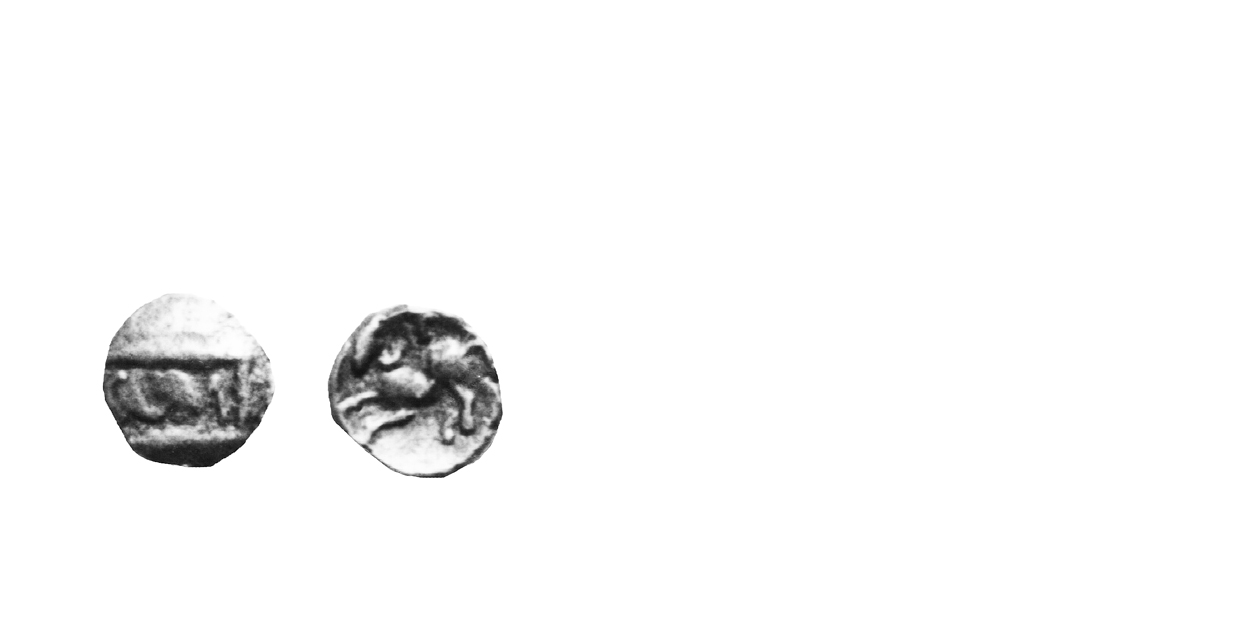
389 - 01 Tincomarus Third Coinage
20-10 B.C. Extremely Rare
Gold Quarter Stater 1.2 gms.
Earliest Record: Mack, 1953
OBV: Inscribed tablet
Identifying points:
- COM in tablet
REV: Celticized horse left
Identifying points:
- T above horse
CLASSIFICATION: Atrebatic F
NOTES:
- Most in museums
- Typical weight given
- Some reported from Wanborough
- Celtic Coin Index records indicate rarer than originally thought
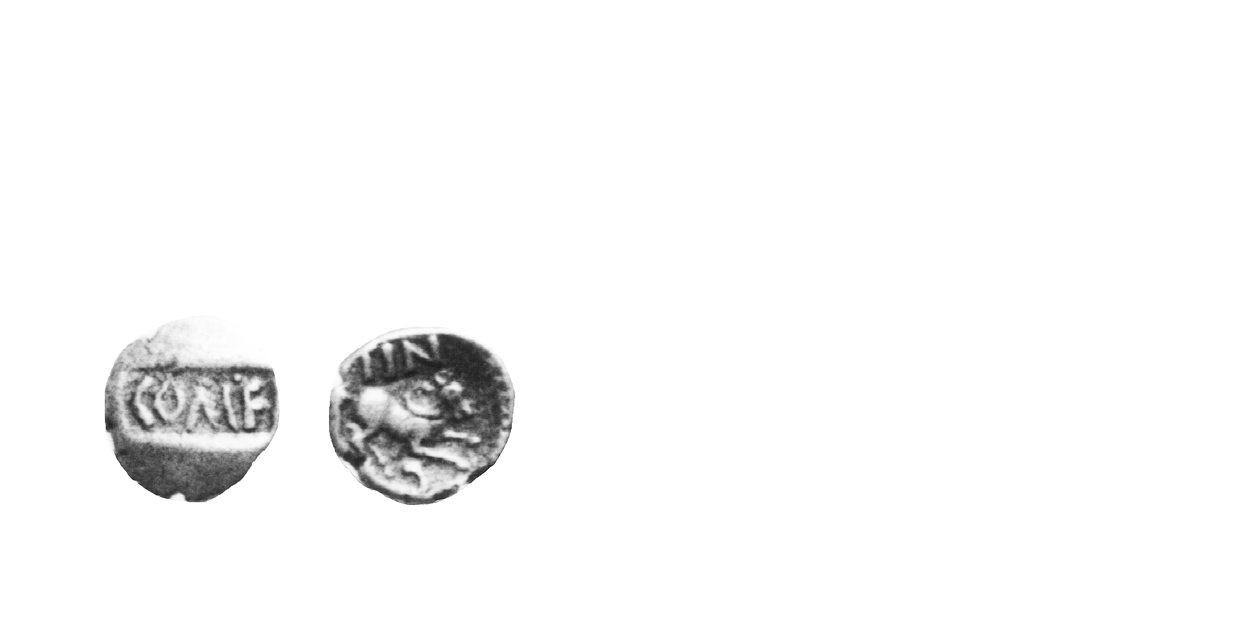
390 - 01 Tincommius Third Coinage
20-10 B.C. Rare
Gold Quarter Stater 1.1 gms. 10 mm
Earliest Record: Poste, 1853
OBV: Inscribed tablet
Identifying points:
- COMF in tablet
REV: Celticized horse right
Identifying points:
- TIN above horse
- C below horse
CLASSIFICATION: Atrebatic F
NOTES:
- Some in museums
- Typical weight given
- Some found at Wanborough
- Celtic Coin Index records indicate about as rare as originally thought
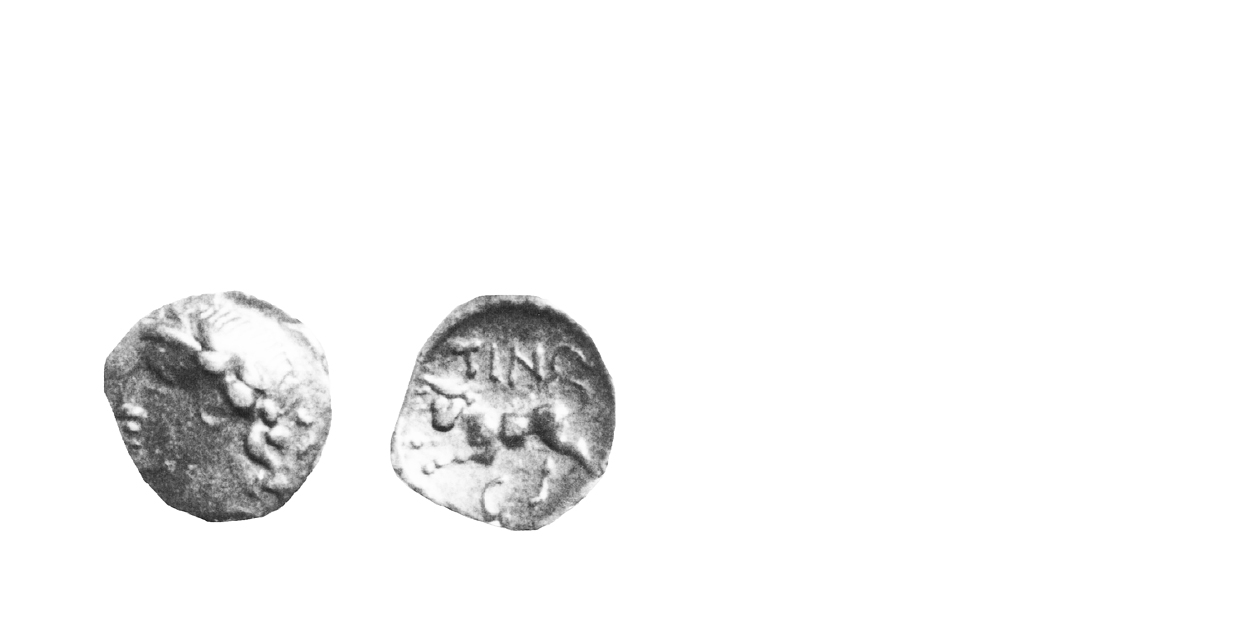
396 - 01 Tincomarus Third Coinage
20-10 B.C. Very rare
Silver Unit 1.3 gms. 11 mm
Earliest Record: Evans, 1890
OBV: Romanized head left
Identifying points:
- head beardless, laureate
REV: Bull charging left
Identifying points:
- TIN above bull
- C below bull
CLASSIFICATION: Atrebatic F
NOTES:
- Some found at Wanborough
- Celtic Coin Index indicates rarer than originally thought
- Reverse adapted from a denarius of L Thorius Balbus
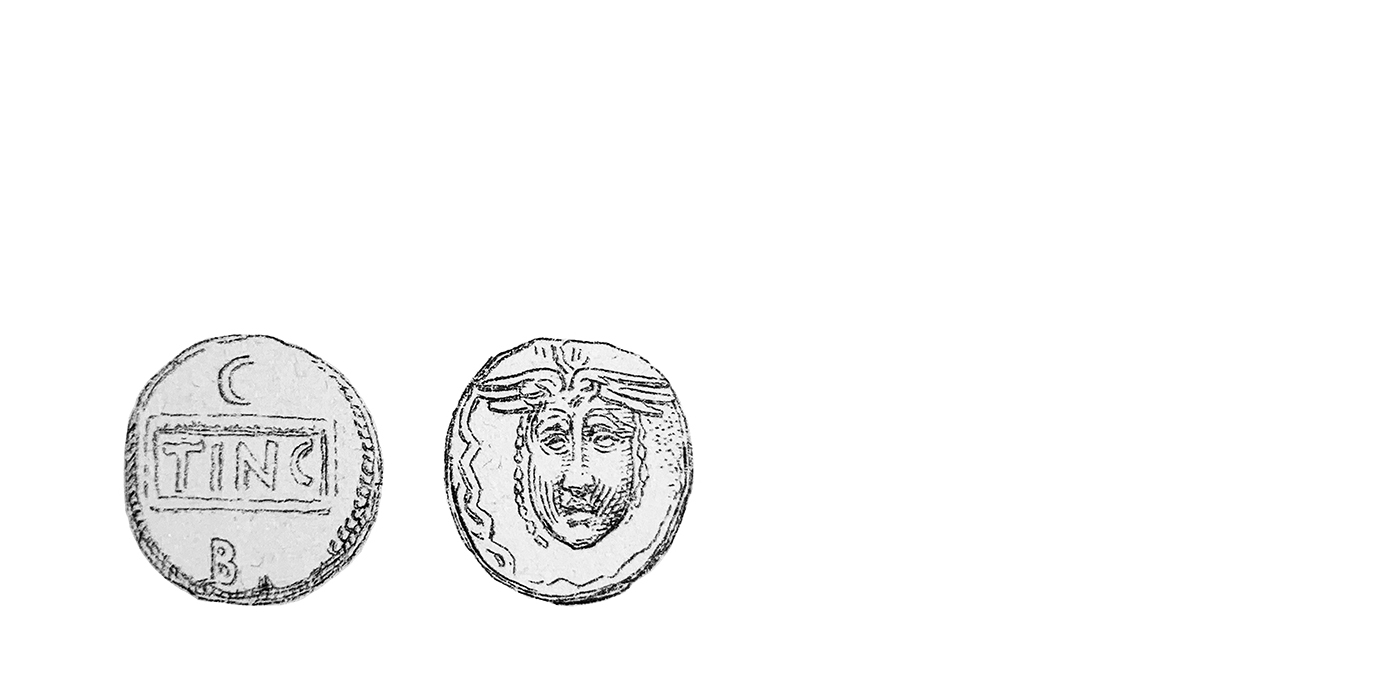
378 - 03 Tincomarus Medusa Type
25-20 B.C. Rare
Gold Quarter Stater 1.0 gm 10 mm
Earliest Record: Evans, 1890
OBV: Inscribed tablet
Identifying points:
- as 378-01 except "B" below tablet
- TINC on tablet
- C above tablet
- B below tablet
- pellet border
REV: Medusa head
Identifying points:
- head faces viewer
- pellet border
CLASSIFICATION: Atrebatic E
NOTES:
- Some in museums
- Typical weight given
- Many found at Wanborough
- Celtic Coin Index records indicate rarer that originally thought
- Evans 1864 reported a variety with "F" below the tablet
- Willett 1879, p. 14 suggested Evans had misread the "F"
- Evans 1890 reported varieties with "A" or "B" below the tablet
- "C" may indicate Calleva mint, the "A" or "B" some subdivision within the mint
- Reverse adapted from a denarius of L. Cornelius Lentulus
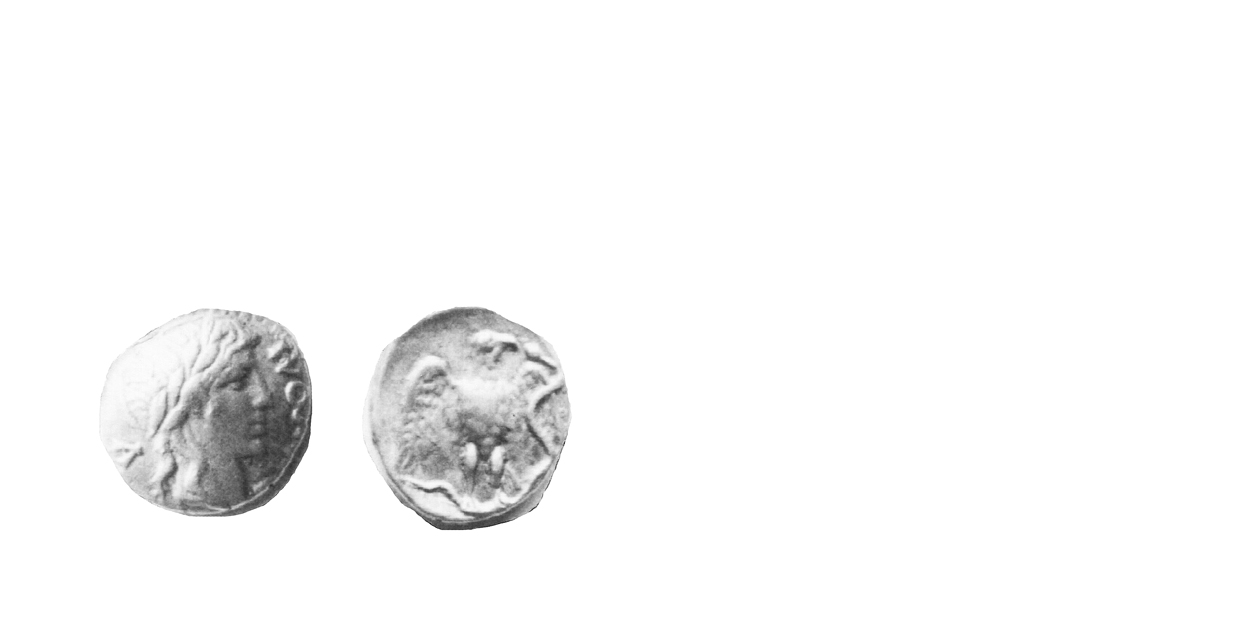
397 - 01 Tincomarus Third Coinage
20-10 B.C. Scarce
Silver Unit 1.0-1.3 gms. 10 mm
Earliest Record: Evans, 1890
OBV: Romanized head right
Identifying points:
- TINCOM in front of face
- head laureate and beardless
REV: Eagle
Identifying points:
- eagle stands with spread wings
CLASSIFICATION: Atrebatic F
NOTES:
- Many found at Wanborough
- Mack indicated the coin was copied from a coin of Augustus
- Both obverse and reverse adapted from denarii of Augustus.
- Celtic Coin Index records indicate rarer than originally thought
Coinage of the Atrebates, Regni & Belgae
The Atrebates, Regni and Belgae occupied the territory that is today Berkshire, Sussex and Hampshire. Whether three distinct political groups struck coins cannot be proven today, nor can separate territories be demonstrated. The Regni are virtually unknown to history until the Roman period, and the tribal area of the Belgae is a matter of controversy. Though Belgic immigration is mentioned by Caesar, he does not specifically say where they settled, and we only have the Roman name Venta Belgarum to suggest a location. The Atrebates, also mentioned by Caesar, had tribal members on both sides of the Channel.
Traditionally, the three tribes have been treated numismatically as one. Based on the current state of research, there is no reason to change this approach. Attempts have been made to identify a separate coinage for the Belgae. These have been largely, but not entirely, based on reports of new types of silver coins published in numismatic trade lists since 1994. The coins do not appear to form a coherent issue of a single issuing authority and questions exist regarding their precise status. These enigmatic coins demand careful analysis and reflection before they are accepted as evidence for a Belgic coinage. Certainly, after the Gallic War, only one coinage circulated in the territory. It may someday come to pass that coinages for the Belgae and Regni can be identified, but only after a rigorous analysis of the new types has been completed. Most of these are listed under "New Material". For the remainder of this discussion the three tribes will be referred to simply as the "Atrebates" for the sake of brevity.
Initially, the three tribes constituted one of the most advanced groups in Britain. They had trading contacts with Belgic Gaul in the late second and early first centuries B.C., and were one of the earliest to strike coins. The earliest stater, the INSULAR TYPE struck before the Gallic War, is derived from imported Gallo-Belgic C. The next coinage, the WESTERHAM TYPE, is now felt to be inspired by the Trinovantian/Catuvellaunian coinage of the same name, struck during the Gallic War. After the war, the tribal position changed dramatically, and the Atrebates may have fallen out of favour with the Romans. It is possible the cross-Channel trading rights were given to the Trinovantes/Catuvellauni instead. A loss of trading rights may have been the result of Commius' activities during the War.
Commius, at first a supporter of Caesar, became disillusioned with the Romans and went over to Vercingetorix. After the collapse of Celtic resistance at Alesia, he fled to join the British part of his tribe. Later, the Atrebates struck coins with his name, and possibly the acceptance of Commius in Britain was the reason they fell out of favour. The change in trading rights altered the relative fortunes of the two tribes forever. By the end of the millennium, the Trinovantes/Catuvellauni had economic influence throughout southern Britain and had begun to rival the Atrebates.
The Atrebates seized the opportunity of the Trinovantian/Catuvellaunian Interregnum to mount a military incursion into Kent under their leader, Eppillus. Eppillus struck a victory stater commemorating the initial success of the expedition. The incursion was cut short, however, by the elevation of Cunobeline to the Trinovantian/Catuvellaunian throne. He drove the Atrebates out of Kent and Eppillus promptly disappeared. He is replaced on the coins by Verica, a self-styled 'son of Commius'.
Sometime before the Claudian invasion, Verica was in turn overthrown. He probably was the historical Celtic leader 'Bericus' who appeared in Rome seeking aid from Claudius. Verica was replaced on the coins by Epaticcus, who styled himself a 'son of Tasciovanus'. Whether the family-tie was real is not so important, the result was the Atrebatic leadership was now held by a Trinovantian/Catuvellaunian sympathizer. Shortly before the Claudian invasion, Epaticcus was replaced by Caratacus, the famous leader of the British resistance against the Roman invaders. The Atrebatic coinage came to an end during the forties, as Caratacus fled westwards to lead the resistance amongst the tribes in Wales. One Atrebatic leader known to history, Cogidubnus, has not yet been identified on the coinage. It seems he was not elevated to leadership until the coinage had come to an end.
